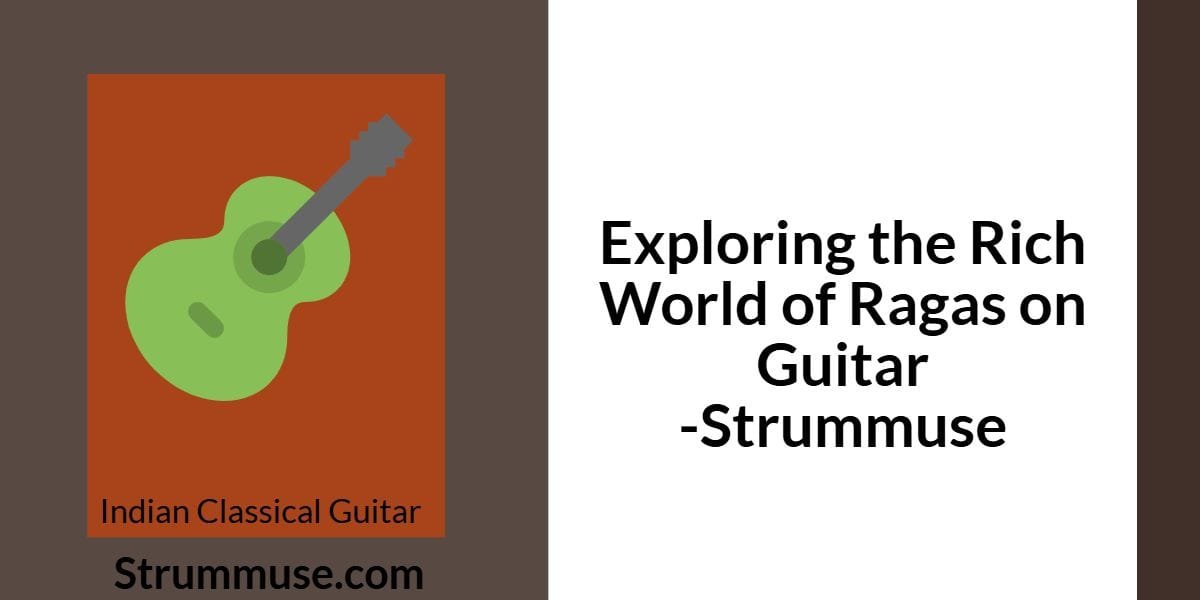A Guitarist’s Soulful Dive into Indian Ragas
Have you ever wondered how to blend the soulful beauty of Indian classical ragas with the familiar feel of your guitar? As a guitarist myself, I remember being curious about the depth and emotion behind ragas. But I also felt a little intimidated—how could I, someone trained mostly in chords and tabs, ever grasp something so intricate?
Turns out, you don’t need to be a classical maestro to start. This guide is here to help fellow guitar lovers—whether you’re just starting out or looking to expand your musical vocabulary—connect with ragas in an easy, enjoyable way.
Let’s dive into the colorful world of Indian ragas and how you can begin exploring them on your guitar.
What Is a Raga, Really?
At its core, a raga isn’t just a scale. It’s a mood, a color, an emotional expression brought to life through melody. It’s like telling a story—but instead of words, you’re using notes.
A raga uses a set of notes (like a Western scale), but it also includes rules on how to approach them:
- Which notes to emphasize
- When to ascend or descend
- What kind of ornamentation (like slides or bends) to use
Each raga has its own character. For instance:
- Raag Bhupali feels serene and devotional
- Raag Bhairav carries a meditative, spiritual vibe
- Raag Yaman sounds romantic and uplifting
As a guitarist, you can bring these moods to life through expressive playing.
Why Learn Ragas on Guitar?
You might be wondering—why should I bother with ragas when there are thousands of songs and chords to learn?
Here’s what exploring ragas on guitar can offer:
- Deeper musical understanding: You’ll understand melody and phrasing on a whole new level.
- Improved lead playing: Ragas encourage melodic phrasing, slides, bends, and note expression.
- Emotional connection: Unlike Western scales, ragas are tied to emotions and times of day—helping you play with true feeling.
- Creative inspiration: Improvising in ragas unlocks new ideas for solos, riffs, and even compositions.
Getting Started: How to Approach Ragas on Guitar
You don’t need to abandon everything you know. Ragas can work with your current skills. Here’s how to ease in:
Step 1: Choose One Raga to Start
Pick something beginner-friendly. Raag Bhupali is a great first choice—it uses 5 notes, like a pentatonic scale.
Step 2: Learn the Notes (Arohana/Avarohana)
Each raga has an ascending (arohana) and descending (avarohana) pattern. For Bhupali:
- Arohana: Sa Re Ga Pa Dha Sa
- Avarohana: Sa Dha Pa Ga Re Sa
On guitar, you can play this on a single string or across positions. Use familiar fretboard patterns.
Step 3: Feel the Mood
Before playing, listen to the raga sung or played on traditional instruments (like flute or sitar). Get a feel for its emotion. Then try to mimic that vibe with your guitar.
Step 4: Practice Phrases (Pakad)
Each raga has common melodic phrases or Pakads. Practice these slowly. These are the “hooks” that define the raga.
Step 5: Start Improvising
Use the notes and pakads to create your own melodies. Try playing over a tanpura drone (you’ll find apps for this), and experiment with timing and ornamentation.
Sample: Playing Raag Bhupali on Guitar
Here’s a simple melodic line for Bhupali:
E|--5--7--9--7--5--7--
B|------------------7--
This line captures the essence of Bhupali in a beginner-friendly way. Add slides or hammer-ons to make it sing.
Must-Read Guides from StrumMuse:
- Raag Bhupali on Guitar: A Journey Through Indian Classical Music
- Raag Bhairav on Guitar
- Exploring the 10 Thaats of Indian Classical Music
- Understanding Guitar Scales
- Mastering Tum Hi Ho – Guitar Chords & Melody
Why You Can Trust This Guide
This post is based on real guitar practice and Indian classical fundamentals. As a guitarist with years of experience exploring melody-based playing, I’m sharing insights not just from theory—but from hands-on learning, mistakes, and breakthroughs.
You’re not getting textbook knowledge here. You’re getting the experience of a fellow learner who loves both the guitar and the magic of Indian melodies.
FAQs: Ragas on Guitar
Q: Can I really play ragas on a regular acoustic guitar? Yes! You don’t need a sitar or classical setup. Just a clean tone, finger control, and feel are enough.
Q: Do I need to learn Indian classical music theory first? Not at all. Start by listening and playing simple ragas like Bhupali or Yaman. Theory can come gradually.
Q: Are ragas and scales the same? No. While both use notes, ragas have rules for how notes are approached and expressed.
Q: Will this help me become a better lead guitarist? Absolutely! Ragas teach phrasing, timing, and emotional playing—key traits of great lead guitar.
Final Thoughts: Let the Strings Sing
If you’ve ever wanted to go beyond scales and play something that feels spiritual and meaningful, ragas are your path. Don’t worry about perfection. Instead, enjoy the process of exploring emotions through your fretboard.
Pick a raga. Listen. Feel it. Then let your guitar translate that feeling into music.
Hello my name is Karansingh. I’m a passionate guitarist and the creator of StrumMuse.com — your trusted guide for Hindi guitar chords, strumming patterns, and beginner-friendly tutorials. With years of personal playing experience, I break down complex techniques into easy-to-follow lessons, helping you learn guitar the fun and effective way. Whether you’re just starting or refining your skills, StrumMuse is your musical companion.
Expertise: Bollywood guitar chords, strumming patterns, fingerstyle
Experience: 5+ years of self-taught guitar learning
Trust: 100+ curated posts helping thousands of learners
Contact: karanbayas0001@gmail.com
